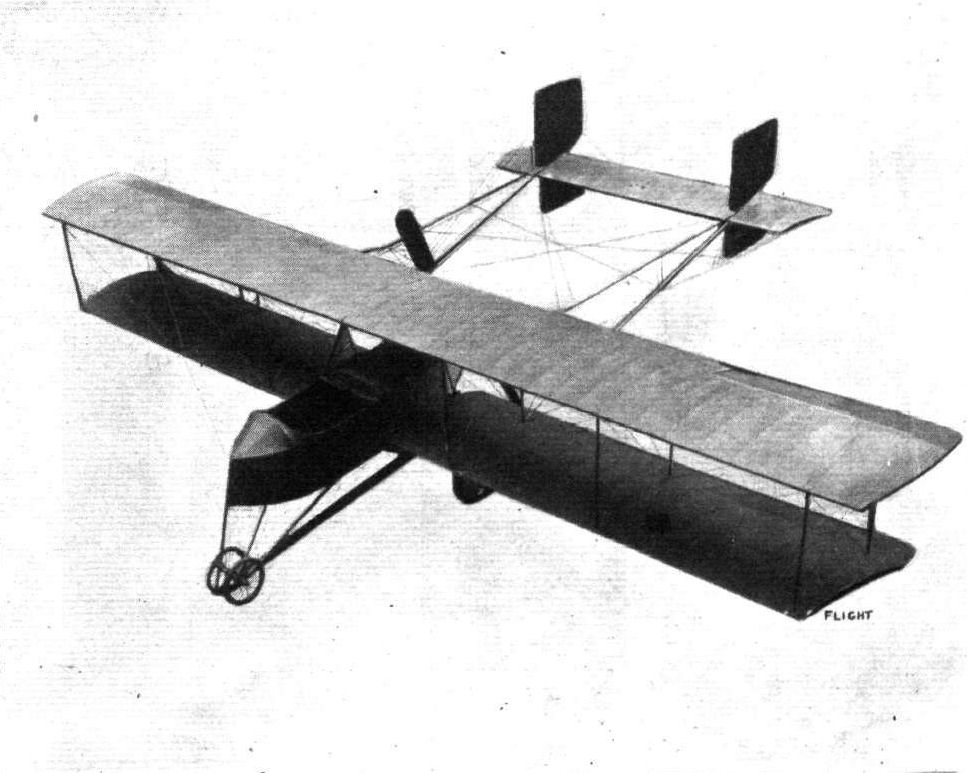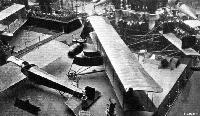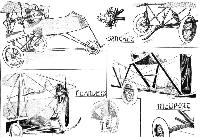L.Opdyke French Aeroplanes Before the Great War (Schiffer)
Deleted by request of (c)Schiffer Publishing
The second Bathiat-Sanchez at the 1913 Salon was another big pusher biplane, looking very much like some of the Voisins of the period, also built partly of metal. The single elevator had no tailplane, and the twin rudders showed above and below it; the tail-booms came together at the elevator leading edge, changing direction along the way and further braced to the tops and bottoms of the 2 rudder posts. The 4-wheel undercarriage was typically Voisin, with a pair of closeset nose-wheels. There were a great many rigging-wires, even for 1913: the machine was dubbed Sanchez-bizarre.
(Span: 13.5 m; length: 10.1 m; wing area: 46 sqm; gross weight: 825 kg; empty weight: 550 kg; speed: c 90 kmh; the 70 hp Renault was soon replaced by an 80 hp Gnome)
And in 1921 appeared the Toussaint, also by Sanchez: it featured no fewer than 21 wings!
Журнал Flight
Flight, December 13, 1913.
THE STANDS AT THE PARIS AERO SHOW.
BATHIAT-SANCHEZ.
Two machines are exhibited on the Bathiat-Sanchez stand; one is the monoplane on which Lieut. Morel made a tour of France, and the other is an all-steel biplane of the "pusher" type which, with a 70 h.p. Renault engine, has attained a speed of 102 kiloms. per hour, and climbed to an altitude of 1,000 metres in 14 mins.
Flight, December 27, 1913.
THE PARIS AERO SALON - 1913.
BATHIAT-SANCHEZ.
<...>
The biplane exhibited by this firm is on more original lines, and belongs, as will be seen from the accompanying illustrations, to the "pusher" type. It is driven by a 70 h.p. Renault engine, mounted on two transverse steel tubes resting in lugs on the upper longerons of the nacelle. As usual, the propeller is mounted on the cam-shaft, and is thus running at half engine speed. The tanks are mounted inside the nacelle in front of the engine, while well out in front are arranged the pilot's and passengers' seats. Accommodation has been provided for pilot and two passengers, the pilot occupying the front single seat, while the passengers' seats are situated side by side just behind the pilot. The controls are of the usual type, consisting of a single lever working the ailerons and elevator, while a pivoted foot-bar actuates the rudder. Just behind the passengers' seats is fitted a starting handle, by means of which the engine may be started without any necessity of swinging the propeller. The main planes, of which the upper one has a slightly larger span than the lower one, are connected by steel tube struts of streamline section; the main spars are also steel tubes, over which are built the ribs, which are constructed of ash. Carried on the rear extremities of an outrigger of somewhat complicated construction are the tail planes, which consist of a single rectangular balanced elevator and two divided rudders, whilst no fixed tail plane is fitted. The tail booms, which are steel tubes, appear to be unnecessarily complicated, and the cross-wiring employed to provide the necessary rigidity would appear to offer quite a lot of head resistance.
The chassis, which is of somewhat unusual type, consists of two main wheels mounted on stub axles and sprung by rubber shock absorbers, while under the nose of the nacelle and supported on another structure of steel tubes, are two smaller wheels. A very stout wooden skid connects the axles of the two pairs of wheels, and terminates at the back in a down-swept heel which takes the place of the ordinary tail-skid. The accompanying illustrations will, we think, explain all the details of the chassis. One point to which we wish to call attention, is the fitting of band brakes to the two main wheels. These brakes are operated by means of a lever on the right hand side of the pilot's seat. For starting the machine the pilot applies the brakes by pulling the lever backwards, and when his engine is running satisfactorily he releases the lever, and the machine starts. The workmanship in both machines is very good, but the biplane, built as it is of steel practically throughout, gives the impression of being rather heavy, although it is said to have attained, with a 70 h.p. Renault engine, a speed of 102 kilometres per hour, and to have climbed to an altitude of 1,000 metres in 14 minutes.
Flight, May 9, 1914.
THE SANCHEZ-BESA BIPLANE.
THE subject of our scale drawings this week, the Sanchez-Besa biplane, which paid a brief visit to Hendon aerodrome during last week-end, is similar in its general arrangement to the machine exhibited at the last Paris Aero Show, when it was fully described in these columns. The chief alteration appears to be that this machine is fitted with an 80 h.p. Salmson engine, whereas the one at the Paris Show had a Renault engine. Also the tail planes have been slightly altered, so that now the rudders are mounted on and move with the elevator. The machine is built of steel almost throughout, and is mainly characteristic on account of its rather unusual type chassis, which consists of two stub axles universally pivoted to the rear end of the very long ash skid, and carrying two large diameter wheels which are sprung by means of rubber shock absorbers attached to telescopic tubes running from the outer end of the stub axle to the rear end of the lower longerons of the nacelle. The front end of the skid is supported on a structure of three steel tubes. Two smaller wheels mounted on a short tubular axle, prevent the machine from turning over on her nose on landing.
The nacelle is built up in the usual way, and provides accommodation for pilot and two passengers, the latter being seated side by side between the pilot's seat and the leading edge of the wings. A wind shield in the nose of the nacelle deflects the air above the heads of the occupants. Behind the passengers' seat and inside the nacelle is mounted a large petrol tank, containing a supply sufficient for a flight of 4 1/2 hours' duration.
The engine, an 80 h.p. Salmson, is mounted between double bearings in the rear of the nacelle, and drives through a spur reduction gearing the large diameter propeller which is situated behind the main planes. The propeller-shaft, which is mounted some seven or eight inches above the upper longerons of the nacelle, is supported on a structure of steel tubes, and has at its rear end a combined thrust and journal ball-bearing. The engine can be started from the passengers' seat by means of a starting handle, thus doing away with the usual swinging of the propeller.
The main planes, which have a comparatively small gap in relation to the chord, are built up of wooden ribs over steel tube spars. Inter-connected ailerons are fitted to both upper and lower planes, and the chord of the ailerons is greater at the tip than at their inner ends in order to render them more efficient. The tail planes are carried on an outrigger formed by four steel tubes, and are unusual in that the two divided rudders are mounted on and move with the elevator, so that when the latter is moved up or down the rudders move backwards and forwards with it. This arrangement necessitates a rather unusual control gear, which consists of the usual central universally pivoted hand lever which operates the elevators through a series of quadrants underneath the nacelle. By means of these quadrants the movement of the elevator is geared up so that for a small movement of the hand lever the elevator is rotated through a comparatively large arc. The whole control gear seems unnecessarily complicated, and it is a question whether a different type tail, which would do away with the use of the quadrants, would not be an improvement. However, the present system appears to work quite satisfactorily, and the machine certainly answers the controls very well, doing right angle turns in apparently less than her own length.
When doing a turn with the rudders only these do not seem to be any too large, but by using the ailerons in conjunction with the rudders exceedingly sharp turns can be effected. The machine appears to be perfectly stable spirally, in spite of the comparatively large side area of the nacelle in front of the centre of gravity, and last Sunday, at Hendon, the pilot - Delaporte - flew the machine in a high wind with both hands off the controls.
A refinement worth noticing in the machine, and one illustrated by the accompanying sketches, are the wheel brakes fitted on the rear wheels. By means of these brakes, which are operated from the pilot's seat, the machine can be held back by the pilot whilst running the engine all out, so that it is possible, by the aid of these brakes, and the starting handle behind the passengers' seat, to start the machine without any outside assistance whatever, a feature which should prove useful for cross-country work where, after having made a forced landing en route, experienced assistants are not always available, and where the help of inexperienced, though willing, assistants may easily cause considerable damage to the machine. Another advantage of the wheel brakes is that on making a landing in confined areas the machine can be stopped after a very short run along the ground; in fact, it appears to be possible to bring it to a standstill after a run of about twice its own length.
The weight of the machine empty is 1,750 lbs., her maximum speed is 65 m.p.h., and the minimum flying speed about 35 m.p.h.
The machine described above has already gone back to France, but we understand that a similar machine, fitted with a 130 h.p. engine, will be coming over here shortly.
Flight, October 29, 1915.
CONSTRUCTIONAL DETAILS.-VIII.
<...>
In the sketches of the undercarriage of the Bathiat-Sanchez biplane is illustrated another method. Here the stub axles, which are universally pivoted to the central skid, are sprung by telescopic tubes both of which carry cross-pieces, to which are attached the rubber shock absorbers. The cross-piece of the inner tube works in a slot in the outer tube, the action being easily understood from an examination of the sketch. A refinement worth noticing in this undercarriage are the wheel brakes illustrated in the detail sketch. By means of these brakes, which are operated from the pilot's seat, the machine can be held back while running the engine, so that it is possible, by the aid of the brakes and the starting handle with which the motor is fitted, to start the machine without any outside assistance.
<...>















